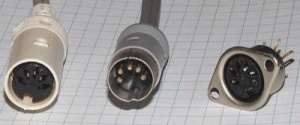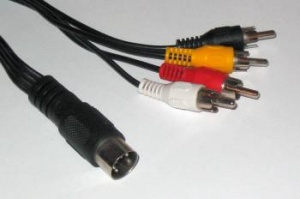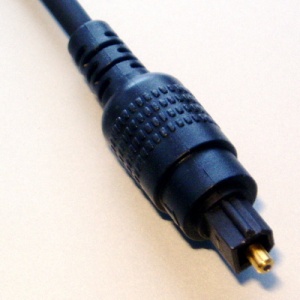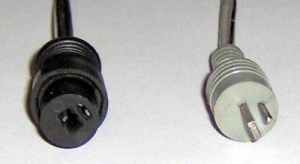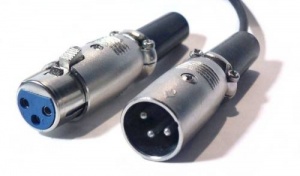Difference between revisions of "Connectors"
m (DIN/Cinch-Adapter) |
|||
| Line 1: | Line 1: | ||
==Analog== | ==Analog== | ||
===Cinch (RCA)=== | ===Cinch (RCA)=== | ||
| − | [[ | + | [[Image:RCA-plug.jpg|thumb|RCA-plug (stereo)]] |
| − | [[ | + | [[Image:RCA-plug-video.jpg|thumb|RCA-plug (stereo+video)]] |
| − | + | In current hi-fi equipment, the [[wp:Cinch|Cinch plug]] is the usual connection for analog signals. The plugs are usually color-coded uniformly depending on the application. | |
| − | + | The most commonly used variant has two connectors for a '''stereo''' connection: | |
| − | * | + | * white: left analog channel (sometimes black or gray). |
| − | * | + | * red: right analog channel |
| − | + | Depending on the application, there is an additional connector for '''video signals''': | |
| − | * | + | * yellow: composite video |
| − | + | Particularly with adapters for DIN plugs, four connections are often used, since the DIN plugs serve as input and output at the same time: | |
| − | * | + | * white: left channel for playback |
| − | + | red: right channel for playback | |
| − | + | black: left channel for recording | |
| − | + | yellow: right channel for recording | |
| − | + | Note: "colorless" connectors on the left, "colorful" connectors on the right, '''w'''eiß/rot for '''W'''iedergabe | |
===DIN=== | ===DIN=== | ||
| − | [[ | + | [[Image:DIN.jpg|thumb|DIN male and female]] |
| − | [[ | + | [[Image:DINCinchAdapter.jpg|thumb|DIN RCA adapter for playback and recording]] |
| − | + | The round, usually 5-pin (stereo) or 3-pin (mono), [[wp:DIN plug|DIN connectors]] are found in hi-fi almost only on older equipment. Here, a single connector is used for recording and playback. A connection to hi-fi equipment with RCA connectors is possible with the help of an adapter, the usual color coding is explained at the RCA connectors. | |
| − | + | In addition, '''loudspeaker connectors''' according to DIN 41529 ("dash-dot plugs") are often found on older devices (until the end of the 1970s): | |
| − | * | + | * round pin: (+) pole |
| − | * | + | * flat pin: (-)-pin |
| − | + | The matching plugs are available from specialist dealers and can be screwed or soldered to the loudspeaker cables. | |
| − | + | Less common are the so-called '''[[wp:Würfelstecker|cube plug]]'', DIN plugs used to connect headphones. The name derives from the arrangement of the pins in the plug in the shape of the number five on a playing dice. With the help of an adapter, these plugs can be used on the jack sockets commonly used today. | |
| − | === | + | ===Jack=== |
| − | [[Image: | + | [[Image:Jackplug.jpg|thumb|from left to right: 2.5 mm mono; 3.5 mm mono; 3.5 mm stereo; 6.35 mm stereo]] |
| − | + | The 3.5 and 6.3 mm [[wp:jack plug|jack plug]] are most commonly used in home audio to connect '''headphones''', with the smaller variant (mini jack) usually used on mobile devices such as MP3 players. More rarely, there is also a variant with a 2.5 mm plug. | |
| − | 3 | + | 3.5 mm jacks are also often found as line outputs on sound cards. With the help of an adapter, it is possible to connect to a cinch connector, e.g. to connect the PC to an amplifier. |
==Digital== | ==Digital== | ||
| − | [[Image:TOSLINK.jpg|thumb|TOSLINK | + | [[Image:TOSLINK.jpg|thumb|TOSLINK connector]] |
| − | + | In home audio, digital transmission is usually based on the [[wp:Sony/Philips Digital Interface|S/P-DIF specification]]. Three connectors are common here: | |
| − | * | + | * RCA (coaxial), connector usually orange, electrical connection. |
| − | * [[wp:TOSLINK|TOSLINK]] ( | + | * [[wp:TOSLINK|TOSLINK]] (optical) |
| − | * | + | * optical jack (3.5 mm) |
| − | + | The conversion between optical/electrical connection is easily possible by means of an adapter. | |
| − | + | Many sound cards now offer digital outputs, so the D/A conversion is handled by the amplifier/receiver or an external D/A converter. Optical connections also have the advantage that the occurrence of [[wp:hum loop|hum loop]] is prevented. | |
| − | == | + | ==Loudspeaker== |
| − | === | + | ===Spring terminals/screw connections=== |
| − | + | Clamp and screw connections, to which the stranded wire of the speaker cable is directly fixed without a plug, are widely used in the loudspeaker sector. In this case, the cable end should not be tinned. With the usual screw connections often [[wp:cable lug|cable lugs]] can be used. | |
| − | === | + | ===Banana plug=== |
| − | [[ | + | [[Image:Banana plug.jpg|thumb|banana plug]] |
| − | [[ | + | [[Image:DIN-LS.jpg|thumb|DIN speaker plug]] |
| − | [[ | + | [[Image:Speakon.jpg|thumb|Neutrik Speakon connector]] |
| − | + | Screw connectors are also often combined with sockets for [[wp:Banana plug|banana plug]]. These 4 mm diameter plugs are mainly designed for use in electrical laboratories and provide a stable connection. | |
| − | + | Caution is advised, as banana plugs can also be plugged into earthed sockets, which can lead to electrical accidents if used improperly. | |
===DIN=== | ===DIN=== | ||
| − | + | On older equipment (up to the end of the 1970s), loudspeaker connectors to DIN 41529 ("dash-dot plugs") are often found: | |
| − | * | + | * round pin: (+)-pin |
| − | * | + | * flat pin: (-)-pin |
| − | + | The matching plugs are available from specialist dealers and can be screwed or soldered to the loudspeaker cables. | |
===Speakon=== | ===Speakon=== | ||
| − | [[wp:Speakon|Speakon]] | + | [[wp:Speakon|Speakon]] is a connector for loudspeakers developed by the company Neutrik. It is characterized by its robustness and the possibility of a secure locking. Speakon connectors with 2, 4 and 8 poles are available. |
==XLR== | ==XLR== | ||
| − | [[ | + | [[image:XLR.jpg|thumb|XLR jack and plug]] |
| − | [[wp:XLR|XLR | + | [[wp:XLR|XLR connectors]] are mainly used in professional applications (recording studios), for connecting microphones and speakers. Increasingly, however, they can also be found in high-quality hi-fi equipment, where they are used for [[wp:Symmetrical signal transmission|symmetrical transmission]] of analog signals. With the help of an adapter, a connection to RCA jacks is possible. |
| − | + | Different cables are used to connect microphones/hifi equipment and speakers. In contrast to the microphone cables, the speaker cables are unshielded and unbalanced. | |
==HDMI== | ==HDMI== | ||
| − | [[wp:HDMI|HDMI]] | + | [[wp:HDMI|HDMI]] is an interface developed in 2003 for the digital transmission of audio and video data. The current version 1.3 also supports up to 7.1 dts-HD Master Audio, Dolby True-HD and Dolby Digital Plus (lossy) audio formats. Audio DVDs and SACD are also supported and transmitted via HDMI from version 1.2a. Currently, there are DVD players and Blu-ray players that have HDMI 1.0a - HDMI 1.3a. Depending on the specification and equipment, not all players and recorders output the same sound formats. The new HD sound formats are currently only offered on Blu-ray Dics due to the high data capacity. |
| + | [[Category:Encyclopedia]] | ||
Latest revision as of 16:20, 9 February 2010
Contents
[hide]Analog
Cinch (RCA)
In current hi-fi equipment, the Cinch plug is the usual connection for analog signals. The plugs are usually color-coded uniformly depending on the application.
The most commonly used variant has two connectors for a stereo connection:
- white: left analog channel (sometimes black or gray).
- red: right analog channel
Depending on the application, there is an additional connector for video signals:
- yellow: composite video
Particularly with adapters for DIN plugs, four connections are often used, since the DIN plugs serve as input and output at the same time:
- white: left channel for playback
red: right channel for playback black: left channel for recording yellow: right channel for recording Note: "colorless" connectors on the left, "colorful" connectors on the right, weiß/rot for Wiedergabe
DIN
The round, usually 5-pin (stereo) or 3-pin (mono), DIN connectors are found in hi-fi almost only on older equipment. Here, a single connector is used for recording and playback. A connection to hi-fi equipment with RCA connectors is possible with the help of an adapter, the usual color coding is explained at the RCA connectors.
In addition, loudspeaker connectors according to DIN 41529 ("dash-dot plugs") are often found on older devices (until the end of the 1970s):
- round pin: (+) pole
- flat pin: (-)-pin
The matching plugs are available from specialist dealers and can be screwed or soldered to the loudspeaker cables.
Less common are the so-called 'cube plug, DIN plugs used to connect headphones. The name derives from the arrangement of the pins in the plug in the shape of the number five on a playing dice. With the help of an adapter, these plugs can be used on the jack sockets commonly used today.
Jack
The 3.5 and 6.3 mm jack plug are most commonly used in home audio to connect headphones, with the smaller variant (mini jack) usually used on mobile devices such as MP3 players. More rarely, there is also a variant with a 2.5 mm plug.
3.5 mm jacks are also often found as line outputs on sound cards. With the help of an adapter, it is possible to connect to a cinch connector, e.g. to connect the PC to an amplifier.
Digital
In home audio, digital transmission is usually based on the S/P-DIF specification. Three connectors are common here:
- RCA (coaxial), connector usually orange, electrical connection.
- TOSLINK (optical)
- optical jack (3.5 mm)
The conversion between optical/electrical connection is easily possible by means of an adapter.
Many sound cards now offer digital outputs, so the D/A conversion is handled by the amplifier/receiver or an external D/A converter. Optical connections also have the advantage that the occurrence of hum loop is prevented.
Loudspeaker
Spring terminals/screw connections
Clamp and screw connections, to which the stranded wire of the speaker cable is directly fixed without a plug, are widely used in the loudspeaker sector. In this case, the cable end should not be tinned. With the usual screw connections often cable lugs can be used.
Banana plug
Screw connectors are also often combined with sockets for banana plug. These 4 mm diameter plugs are mainly designed for use in electrical laboratories and provide a stable connection.
Caution is advised, as banana plugs can also be plugged into earthed sockets, which can lead to electrical accidents if used improperly.
DIN
On older equipment (up to the end of the 1970s), loudspeaker connectors to DIN 41529 ("dash-dot plugs") are often found:
- round pin: (+)-pin
- flat pin: (-)-pin
The matching plugs are available from specialist dealers and can be screwed or soldered to the loudspeaker cables.
Speakon
Speakon is a connector for loudspeakers developed by the company Neutrik. It is characterized by its robustness and the possibility of a secure locking. Speakon connectors with 2, 4 and 8 poles are available.
XLR
XLR connectors are mainly used in professional applications (recording studios), for connecting microphones and speakers. Increasingly, however, they can also be found in high-quality hi-fi equipment, where they are used for symmetrical transmission of analog signals. With the help of an adapter, a connection to RCA jacks is possible.
Different cables are used to connect microphones/hifi equipment and speakers. In contrast to the microphone cables, the speaker cables are unshielded and unbalanced.
HDMI
HDMI is an interface developed in 2003 for the digital transmission of audio and video data. The current version 1.3 also supports up to 7.1 dts-HD Master Audio, Dolby True-HD and Dolby Digital Plus (lossy) audio formats. Audio DVDs and SACD are also supported and transmitted via HDMI from version 1.2a. Currently, there are DVD players and Blu-ray players that have HDMI 1.0a - HDMI 1.3a. Depending on the specification and equipment, not all players and recorders output the same sound formats. The new HD sound formats are currently only offered on Blu-ray Dics due to the high data capacity.
